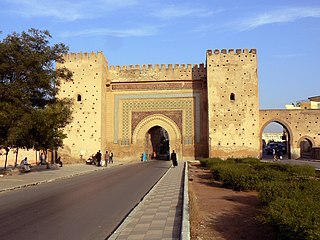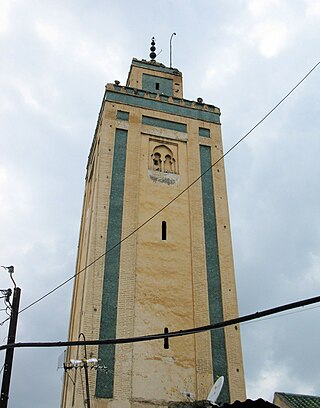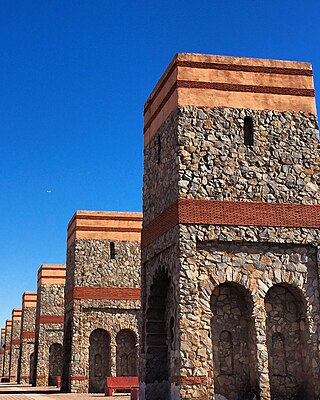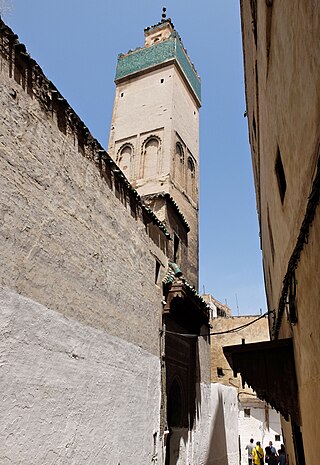A marabout is a Muslim religious leader and teacher who historically had the function of a chaplain serving as a part of an Islamic army, notably in North Africa and the Sahara, in West Africa, and (historically) in the Maghreb. The marabout is often a scholar of the Qur'an, or religious teacher. Others may be wandering holy men who survive on alms, Sufi Murshids ("Guides"), or leaders of religious communities.

Meknes is one of the four Imperial cities of Morocco, located in northern central Morocco and the sixth largest city by population in the kingdom. Founded in the 11th century by the Almoravids as a military settlement, Meknes became the capital of Morocco during the reign of Sultan Moulay Ismaïl (1672–1727), son of the founder of the Alaouite dynasty. Moulay Ismaïl created a massive imperial palace complex and endowed the city with extensive fortifications and monumental gates. The city recorded a population of 632,079 in the 2014 Moroccan census. It is the seat of Meknès Prefecture and an important economic hub in the region of Fès-Meknès.

Asilah is a fortified town on the northwest tip of the Atlantic coast of Morocco, about 31 km (19 mi) south of Tangier. Its ramparts and gateworks remain fully intact.

Moulay Idriss, Moulay Driss Zerhoun or simply Zerhoun is a town in the Fès-Meknès region of northern Morocco, spread over two hills at the base of Mount Zerhoun. It is famous for being the site of the tomb of Idris I, the first major Islamic ruler of Morocco, after whom the town is named. It is located near Meknes and overlooks the ruins of Volubilis a few kilometers away.

Fes el Bali is the oldest walled part of Fez, the second largest city of Morocco. Fes el Bali was founded as the capital of the Idrisid dynasty between 789 and 808 AD. UNESCO listed Fes el Bali, along with Fes Jdid, as a World Heritage Site in 1981 under the name Medina of Fez. The World Heritage Site includes Fes el Bali's urban fabric and walls as well as a buffer zone outside of the walls that is intended to preserve the visual integrity of the location. Fes el Bali is, along with Fes Jdid and the French-created Ville Nouvelle or “New Town”, one of the three main districts in Fez.
For the teacher of Ash-Shadhili see Abu Abdallah ibn Harzihim

The Zawiya of Moulay Idris II is a zawiya in Fez, Morocco. It contains the tomb of Idris II, who ruled Morocco from 807 to 828 and is considered the main founder of the city of Fez. It is located in the heart of Fes el-Bali, the UNESCO-listed old medina of Fez, and is considered one of the holiest shrines in Morocco. The current building experienced a major reconstruction under Moulay Ismail in the early 18th century which gave the sanctuary its overall current form, including the minaret and the mausoleum chamber with its large pyramidal roof.

The Marinid Tombs or Merenid Tombs are a set of ruined monumental tombs on a hill above and north of Fes al-Bali, the old city of Fez, Morocco. They were originally a royal necropolis for the Marinid dynasty which ruled over Morocco in the 13th to 15th centuries. Today, they are a popular lookout point over the historic city.

The architecture of Fez, Morocco, reflects the wider trends of Moroccan architecture dating from the city's foundation in the late 8th century and up to modern times. The old city (medina) of Fes, consisting of Fes el-Bali and Fes el-Jdid, is notable for being an exceptionally well-preserved medieval North African city and is classified as a UNESCO World Heritage Site. A large number of historic monuments from different periods still exist in it today, including mosques, madrasas, synagogues, hammams (bathhouses), souqs (markets), funduqs (caravanserais), defensive walls, city gates, historic houses, and palaces.

Place Bou Jeloud, also known as Place Pacha el-Baghdadi, is a large public square in Fes, Morocco, located west of Bab Bou Jeloud gate.

Bab Mahrouk, also spelled Bab Mahruq, is historically the main western city gate of Fes el Bali, the old walled city of Fes, Morocco. The gate dates from 1204 and is located on the northwestern corner of Place Bou Jeloud, near the edge of Kasbah an-Nouar. It was historically the approximate starting point of the old city's main street, Tala'a Kebira.

Bab Ftouh is the main southeastern gate of Fes el-Bali, the old walled city of Fes, Morocco.

Bab Guissa or Bab Gisa is the main northwestern gate of Fes el Bali, the old walled city of Fes, Morocco.

The Moulay Abdallah Mosque or Mosque of Moulay Abdallah is a major mosque and royal necropolis complex situated in the center of the Moulay Abdallah district in Fes el-Jdid, the historic palace-city and citadel in Fes, Morocco. It was founded by the Alaouite sultan Moulay Abdallah who is buried in the adjoining necropolis along with later members of the dynasty.

The Zawiya al-Nussak is a historic zawiya located just outside the old city walls of Salé, Morocco.

The Zawiya of Sidi Abd el-Aziz is an Islamic religious complex (zawiya) in Marrakesh, Morocco. It is centered around the tomb of the Muslim scholar and Sufi saint Sidi Abu Faris Abd al-Aziz Abd al-Haq at-Tabba', who died in Marrakesh in 1508. Sidi Abd el-Aziz is considered one of the Seven Saints of Marrakesh, and his tomb was a prominent stop for pilgrims to Marrakesh. The zawiya is located on Rue Mouassine at its intersection with Rue Amesfah.

The Zawiya of Sidi Muhammad Ben Sliman al-Jazuli is an Islamic religious complex (zawiya) in Marrakesh, Morocco. It is centered around the tomb of the 15th-century Muslim scholar and Sufi saint Muhammad al-Jazuli, who is one of the Seven Saints of Marrakesh.

The Seven Saints of Marrakesh or Patron Saints of Marrakesh are seven historical Muslim figures buried in Marrakesh, Morocco. Each of them was a famous Muslim judge, scholar or Sufi saint (wali) venerated for their piety or other mystical attributes. Their tombs form the basis of a centuries-old annual pilgrimage, a ziyara, during which visitors pray at each of their tombs over the course of seven days.

The Zawiya of Sidi Taoudi Ben Souda is a zawiya and mosque in Fes el-Bali, the old medina of Fes, Morocco. It is named after Muḥammad al-Tāwdī Ibn al-Ṭālib Ibn Sūda al-Murrī, an 18th-century Sufi sheikh who is considered by some to be one of the foremost intellectuals and Muslim scholars of Morocco's history.
Sidi Harazem is a town in the prefecture of Fez, Morocco. It is a suburb or outlying town roughly 12 kilometers east of Fez, and includes the town centre of Skhinate as well as the Sidi Harazem Bath Complex, a popular thermal bath. According to the 2014 census it had a population of 5622. The town is named after a local 12th-century Sufi scholar, Ali ibn Harazim.


















